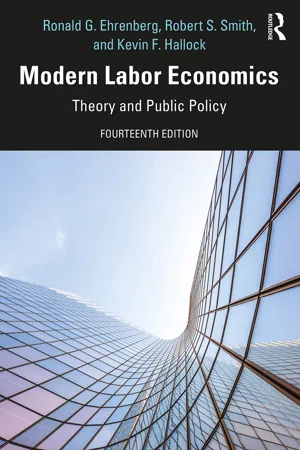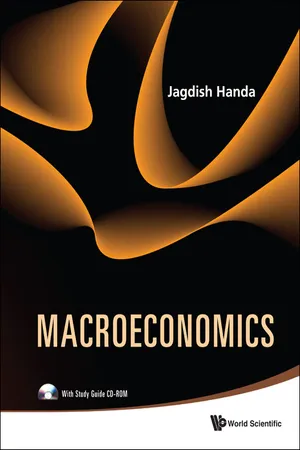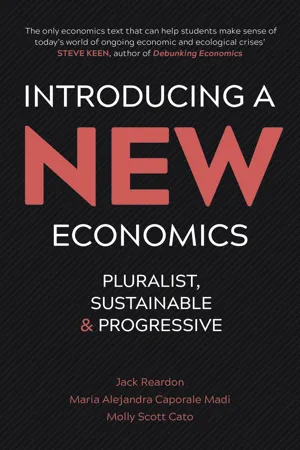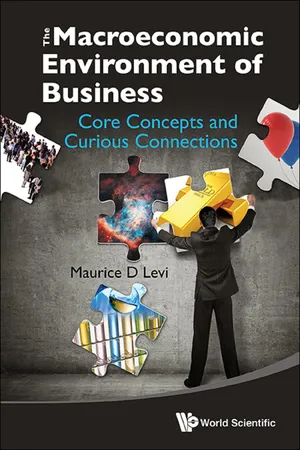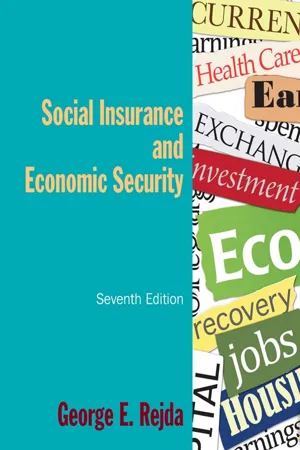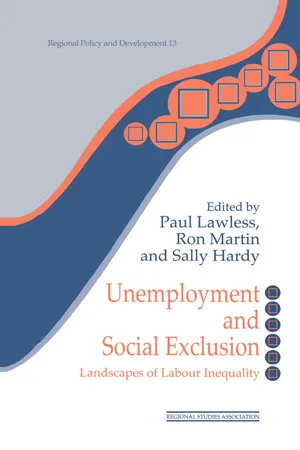Economics
Unemployment
Unemployment refers to the condition of individuals who are willing and able to work but are unable to find employment. It is a key indicator of the health of an economy and is typically measured as a percentage of the labor force. High levels of unemployment can lead to reduced consumer spending, lower economic growth, and social issues.
Written by Perlego with AI-assistance
Related key terms
Related key terms
1 of 4
Related key terms
1 of 3
11 Key excerpts on "Unemployment"
- eBook - ePub
Modern Labor Economics
Theory and Public Policy (International Student Edition)
- Ronald G. Ehrenberg, Robert S. Smith(Authors)
- 2017(Publication Date)
- Routledge(Publisher)
Chapter 14 UnemploymentWith the dramatic rise in Unemployment in the Great Recession of 2007–2009 has come a renewed interest in understanding both the measurement and— more importantly—the causes of Unemployment. As noted in chapter 2 , the population can be divided into those people who are in the labor force (L ) and those who are not (N ). The labor force consists of those people who are employed (E ) and those who are unemployed but would like to be employed (U ). The concept of Unemployment is somewhat ambiguous, since, in theory, virtually anyone would be willing to be employed in return for a generous enough compensation package. Economists tend to resolve this dilemma by defining Unemployment in terms of an individual’s willingness to be employed at some prevailing market wage. Government statistics take a more pragmatic approach, defining the unemployed as those who are on temporary layoff waiting to be recalled by their previous employer, or those without a job who have actively searched for work in the previous month (of course, “actively” is not precisely defined).Given these definitions, the Unemployment rate (u) is measured as the ratio of the number of the unemployed to the number in the labor force:u =Much attention is focused on how the national Unemployment rate varies over time and how Unemployment rates vary across geographic areas and age/race/gender/ethnic groups.U L( 14.1 )It is important, however, to understand the limitations of Unemployment rate data. They do reflect the proportion of a group that, at a point in time, actively want to work but are not employed. For a number of reasons, however, they do not necessarily provide an accurate reflection of the economic hardship that members of a group are suffering. First, individuals who are not actively searching for work, including those who searched unsuccessfully and then gave up, are not counted among the unemployed (see chapter 7 - eBook - ePub
Labour Economics
Unlocking the Secrets of Labour Economics, Navigating Work, Wages, and Economic Impact
- Fouad Sabry(Author)
- 2023(Publication Date)
- One Billion Knowledgeable(Publisher)
Chapter 3: Unemployment
OECD (Organisation for Economic Co-operation and Development) defines Unemployment as people over a certain age (usually 15) Numerous causes can lead to Unemployment, including the following:: New innovations and technologies the economic status, which can be affected by a recession. competition resulting from globalization and global trade Governmental initiatives regulation and marketA country's fiscal policy, for instance, can have an effect on Unemployment and the state of the economy. In addition, the monetary policy of a country's monetary authority, such as the central bank, can affect the availability and cost of money.In addition to Unemployment theories, a few Unemployment categorizations are used to more precisely model the effects of Unemployment on the economic system. Included among the most common types of Unemployment are structural Unemployment, frictional Unemployment, cyclical Unemployment, involuntary Unemployment, and classical Unemployment. The focus of structural Unemployment is on underlying problems in the economy and inherent inefficiencies in labor markets, such as a mismatch between the supply and demand for laborers with the required skill sets. Causes and solutions related to disruptive technologies and globalization are emphasized in structural arguments. Frictional Unemployment discussions center on voluntary decisions to work based on an individual's evaluation of their own work in comparison to current wage rates and the time and effort required to find a job. Causes and remedies for frictional Unemployment frequently involve the employment threshold and wage rates.In 2018, the International Labour Organization (ILO) of the United Nations reported that 172 million people worldwide (or 5 percent of the reported global workforce) were unemployed. Unemployment in Mexico 2009The condition of being unemployed and actively seeking employment is known as Unemployment. Economists differentiate between overlapping types and theories of Unemployment, such as cyclical or Keynesian Unemployment, frictional Unemployment, structural Unemployment, and the classical definition of Unemployment. Occasionally mentioned additional types of Unemployment include seasonal Unemployment, persistent Unemployment, and hidden Unemployment. - eBook - ePub
Modern Labor Economics
Theory and Public Policy
- Ronald Ehrenberg, Robert Smith, Kevin Hallock(Authors)
- 2021(Publication Date)
- Routledge(Publisher)
CHAPTER 14 UnemploymentWith the dramatic rise in Unemployment in the Great Recession of 2007–2009 and then with the spike during the COVID-19 crisis has come a renewed interest in understanding both the measurement and—more importantly—the causes of Unemployment. As noted in Chapter 2 , the population can be divided into those people who are in the labor force (L) and those who are not (N). The labor force consists of people who are employed (E) and those who are unemployed but would like to be employed (U). The concept of Unemployment is somewhat ambiguous because, in theory, almost anyone would be willing to be employed in return for a generous-enough compensation package. Economists tend to resolve this dilemma by defining Unemployment in terms of an individual’s willingness to be employed at some prevailing market wage. Government statistics take a more pragmatic approach, defining unemployed people as those who are on temporary layoff waiting to be recalled by their previous employer, or those without a job who have actively searched for work in the previous month (of course, “actively” is not precisely defined1 ).Given these definitions, the Unemployment rate (u) is measured as the ratio of the number of unemployed people to the number people in the labor force:Much attention focuses on how the national Unemployment rate varies over time and how Unemployment rates vary across geographic areas and age/race/gender/ethnic groups.(14.1)u =U LHowever, Unemployment rate data have limitations. They do reflect the proportion of a group that, at a point in time, actively want to work but are not employed. For a number of reasons, however, they do not necessarily provide an accurate reflection of the economic hardship that members of a group experience. First, individuals who are not actively searching for work, including those who searched unsuccessfully and then gave up, are not counted among unemployed people (see Chapter 7 ).2 - eBook - ePub
Macroeconomics
(With Study Guide CD-ROM)
- Jagdish Handa(Author)
- 2010(Publication Date)
- WSPC(Publisher)
Source: For data 1960–1970 Constance Sorrentino, International comparisons of labor force participation, 1960–1980. CANSIM V2062816 for Canada 1980-2008. Bureau of labour statistics for US 1980–200810.2 The Components of Unemployment The above definitions of the labor force and labor supply imply several concepts of Unemployment. An unemployed worker can belong to any one of four categories:Voluntary Unemployment (U voluntary = L max – L ): those workers who do not have jobs because they want a wage higher than the current one for their skills. Macroeconomics does not consider such workers as really a part of Unemployment, so that such persons are not included in the measures of Unemployment.Structural Unemployment (including seasonal one6 ) (Ustructural = L – ns ): those workers who are in the labor force but do not have jobs because they do not possess the requisite characteristics (skills, location etc.) to get jobs with a productivity which would cover the going wage.Frictional Unemployment (Ufrictional = ns – ns ’matched ): those workers who have the requisite characteristics and for whom there are enough jobs in the economy but who are temporarily unemployed while they search for an appropriate job.7Involuntary Unemployment (Uinv = ns ’matched – nd ’matched - eBook - ePub
Introducing a New Economics
Pluralist, Sustainable and Progressive
- Jack Reardon, Maria Alejandra Caporale Madi, Molly Scott Cato(Authors)
- 2017(Publication Date)
- Pluto Press(Publisher)
subcontracting, consultancies, multiple job-holding, youth internships, and working out of the home, as well as more multiple wage-earning families and early retirees . . . [Such] workers do not easily fit into the traditional categories] of the unemployed, employed, or those out of the labour force . . . [Their] income is ever more decoupled from traditional employment relationships.And given cloud sharing and job sharing, with no sharp distinction between work and leisure, then what does employment mean specifically? Baxandall again (Ibid.: 3):The concept of Unemployment is in flux. We knew when the post-war steelworker was unemployed, and that this was politically destabilising; but it is not at all clear how we should apply these categories to today’s Internet consultant, temp-worker, or independent sub-contractor. The future political economy of Unemployment will depend very much on the changing world of work and how it is regulated.New definitions of employment and Unemployment are currently being researched, but many people, institutions and governments are stuck in the old way of thinking and, thus any transition to a new conceptualisation will not be easy. An important lesson, however, is that in order to solve a problem we first must conceptualise and define it. This must be contextual, that is, we must define the problem not in an absolute sense but in the context of current economic conditions. Indeed, Baxandall (Ibid.: 4) writes:Unemployment is a socially-constructed benchmark used for evaluating the competency of economic rule. In different places and in different times the category of ‘Unemployment’ has included different kinds of joblessness and excluded others. It has implied different kinds of commitments or accountability by the state.Not to change or revise our ideas is to risk misdiagnosis of the problem. As economic systems evolve, so must our thinking. But for now we must work with the current definitions, while understanding their shortcomings and helping to devise new conceptualisations. - eBook - ePub
The Macroeconomic Environment of Business
Core Concepts and Curious Connections
- Maurice D Levi(Author)
- 2014(Publication Date)
- WSPC(Publisher)
CHAPTER 5Unemployment“It’s not what you pay a man, but what he costs you that counts.”Will RogersKey Concepts: Measuring Unemployment; different causes of Unemployment; the meaning of “full employment”; search theory of Unemployment; aggregate supply of and demand for labor; Unemployment and wage inflexibility; inflation versus Unemployment; the natural rate of Unemployment.Each month, government officials, business analysts and others await the release of the Unemployment statistics, hoping to obtain a picture of the general direction of the economy. Behind the cold, harsh facts of the Unemployment figures lies the hardships and dejection of those unable to find suitable work. In this chapter, we examine a number of aspects of Unemployment, including the way it is measured, what is meant by “full employment,” whether full employment is necessarily accompanied by inflation, and why full employment rarely prevails. We shall see that to a large extent, Unemployment is caused by inflexibility in the wage rate, and that contrary to popular opinion, there is no permanent solution to Unemployment from adopting inflationary macroeconomic policies.MEASURING AND CATEGORIZING UnemploymentMeasuring UnemploymentUnemployment is not as clear-cut a concept as would appear from the confident way the term is used in everyday language. While many people know that it is the percent of the workforce without employment, what is not so well known is what exactly constitutes the workforce, and who in particular is counted as being unemployed.In the United States, the size of the workforce and the number who are considered unemployed are determined via monthly household surveys by the Department of Labor of the U.S. Bureau of the Census. In these surveys and similar ones conducted in other countries, the relevant magnitudes are determined as follows: - Merijn Knibbe(Author)
- 2019(Publication Date)
- Routledge(Publisher)
actively are trying to change, to show the (at the micro-level) involuntary nature of Unemployment. A 1967 Bureau of Labor Statistics Report by Robert Stein shows that these remarks were taken to heart and incorporated in the survey questions which are used to measure ‘Unemployment’ (Stein 1967). Card however shows that these survey questions and the basic framework – Unemployment as situation people actively try to change, aggregated individual data, a distinction between the labor force and people outside the labor force – dates back to the endeavors of US economic statisticians – not academic economists – at the end of the 1930s (Card 2011).Later, the ILO adopted comparable recommendations which meant that, basically, US definitions were disseminated to statistical offices all over the world. This makes ‘measured Unemployment’ at the micro-level ‘active’, ‘involuntary’ as well as a (micro) disequilibrium situation. Taking the cyclical pattern of not just U-3 Unemployment but also broad Unemployment into account economists clearly had even more to explain than Keynes in the 1930s and they had more data than ever to do this, while ‘classical’ inspired economists also had a job to do: they had to explain how a very cyclical variable which, on the micro-level, is involuntary by statistical definition can, on the macro-level, be described as ‘leisure’. However, they failed. In the new classical DSGE models Unemployment still does not exist and is mistaken for leisure. Consider neoclassical economists Ljunqvist and Sargent (2016), read ‘Unemployment’ for ‘leisure’: ‘An employed worker gets labor income equal to the wage w and no leisure. An unemployed worker receives value of leisure z > 0 and no labor income- eBook - ePub
- George E. Rejda(Author)
- 2015(Publication Date)
- Routledge(Publisher)
• The Unemployment rate is the number of unemployed as a percentage of the civilian labor force; the labor force comprises all persons classified as employed or unemployed in the civilian noninstitutional population age 16 and over.• Widespread Unemployment has certain economic costs: loss of the GDP that could have been produced; loss of millions of years of labor; and retardation of economic growth. Noneconomic costs include deterioration in work skills, lower self-esteem, and deterioration of family life.• The underemployed include workers employed below their actual or potential skill level, people outside the labor force seeking work, and involuntary part-time workers.• Groups with high Unemployment rates, as of 2011, include blacks, Hispanics, Native Americans, teenagers, older workers, and high school dropouts.• Approaches for reducing Unemployment include expansionary monetary and fiscal policy, Unemployment compensation benefits, improved labor market information, employment and training programs, and federal tax credits to employers.• - eBook - ePub
Unemployment and Social Exclusion
Landscapes of Labour inequality and Social Exclusion
- Sally Hardy, Paul Lawless, Ron Martin(Authors)
- 2013(Publication Date)
- Routledge(Publisher)
Rubery 1992a ). In short, we do not have an active labour market policy which reacts quickly and effectively to employment loss by providing positive signals and direction. The delayed, dilatory response that typifies current policy practice follows directly from the counter-revolution and its emphasis on inflation reduction as the key economic objective. The short-term unemployed and flows into Unemployment are assumed to maintain the effective labour reserve. Policies which reduce their numbers would add to inflationary pressure. Labour market policy should thus address flows out of Unemployment, and particularly the long-term unemployed because they are so far removed from opportunity that a reduction in long-term Unemployment will do little to add to the bargaining power (inflationary threat) of labour. The claim that we should react to those without work only when it is quite clear that loss of opportunity is lasting deserves a direct challenge. Probability of escape from Unemployment certainly declines the longer people are without work. With long Unemployment, skills deteriorate; the habit of regular work may be lost; the self-respect and self-confidence of the individual and the view of the potential employer change. But it is surely preferable to prevent the flows into Unemployment in the first place. A policy approach which develops from the counter-revolution will be hard on the unemployed, but soft on the causes of Unemployment. If one wishes to understand – rather than disguise or deny – Unemployment, the counterrevolution is not the ideal philosophy.Recognising Unemployment: Regions and Structural Change
Involuntary Unemployment is the product of a cumulative process which is triggered by an initial decline in key sectors of the local economy. Modern Unemployment takes its characteristic form from the employment relationship within large industrial units. Such employment requires a clear separation between the formal and the informal economy: a clear divide between organised and casual work. When this form of secure employment disappears, a gap or space emerges within the community and around the individual. That gap or space is the essence of Unemployment (see Piore 1987 ). It cannot simply be assumed that work is always available to those who are truly flexible; to bridge the gap may require a collective response as well as individual initiative. Experience in work does not necessarily translate into alternative productive activity and without capital, without organisation, the individual and the community lack direction. The Unemployment which follows major plant closures and cutbacks is not indicative of a sudden taste for leisure on the part of the workers involved. Neither can it be explained in terms of productive job search.The internal labour market literature (see Doeringer and Piore 1985 - eBook - ePub
- William H. Beveridge(Author)
- 2014(Publication Date)
- Routledge(Publisher)
143. For the period between the two World Wars, there is a full record of severe Unemployment in Britain and there are records which leave little doubt that during the nineteen-thirties Unemployment was substantially more serious in the United States than in Britain, to compensate for its lesser seriousness before 1930. In this period each country experienced a particularly severe return of cyclical fluctuation; though more violent in Britain than anything experienced, at least since 1850, this fluctuation was of the same general character as former fluctuations—was a fresh manifestation of the international trade cycle. The boom which ended this fluctuation in 1937 and heralded the beginning of a new depression, left 10 per cent of the labour force unemployed in Britain and about 12 per cent unemployed in the United States. As regards the United States, this high Unemployment at the top of a cyclical boom cannot be explained as due to structural Unemployment. If that explanation is offered for Britain, the answer is that failure for nearly twenty years to deal with structural Unemployment is in itself a serious weakness of the unplanned market economy. Because such demand as was generated by this economy for the products of industry was so weak, it was not effective in overcoming industrial friction; because it was so badly located with reference to the supplies of available labour, it made that friction abnormally strong.144. The need for a new attack on the problem of Unemployment cannot be denied to-day, except in a mood of unthinking optimism. The attack must be on three lines. There is Unemployment due to chronic or recurrent deficiency of demand. There is Unemployment due to mis-direction of demand. There is Unemployment due to the degree to which the labour market remains unorganized and to the manner in which particular industries respond to demand. The reduction of Unemployment to a harmless minimum requires, therefore, measures of three kinds; measures to ensure sufficient steady demand for the products of industry; measures to direct demand with regard to the labour available; measures to organize the labour market and to assist the supply of labour to move in accord with demand.1 See para. A 42 in Appendix A .1 Memoranda on British and Foreign Trade and Industry (Second Series), 1904 (Cd. 2337).2 - Lois Recascino Wise(Author)
- 2021(Publication Date)
- Routledge(Publisher)
5 The Structure and Dynamics of Unemployment DOI: 10.4324/9780429043277-5The rate of Unemployment in the United States has historically been high in comparison with some other OECD countries, but the duration of Unemployment experienced by single individuals has generally been lower. During the mid-1980s the rate of Unemployment improved overall in the United States. In 1986, the national Unemployment rate equaled 7 per cent of the civilian work force which compares rather favorably to the trends observed in OECD nations.67 During 1987, the rate of Unemployment continued to decline, remaining below 6 per cent of the work force during the last quarter of 1987 and through 1988. In 1987, the level of Unemployment fell below eight million cases for the first time this decade affecting 7.4 million Americans in 1987 (see Table 5.1 ).The current pattern of decline in the rate of Unemployment is somewhat puzzling in that it runs counter to Okun's Law, which posits that the rate of growth in the GNP determines the rate of change in Unemployment. Okun's original formula specified a 4 per cent rate of growth to reduce the level of Unemployment, but later revisions to this estimate allowed that a 2.5 rate of growth in GNP was sufficient to reduce the rate of Unemployment. Now, even that revised formula appears to have broken down in that Unemployment has declined more rapidly than would be anticipated during a period of weak economic growth.68At the same time, the declines occurring in the rate of Unemployment have not been associated with an increase in the rate of wage inflation. In the current period, there is an apparent decline in the nonaccelerating inflation rate of Unemployment (NAIRU), which is discussed in Chapter 4 .Reasons for Unemployment. In recent years, about half of those who are jobless cite involuntary reasons, as the data reported in Table 5.1
Index pages curate the most relevant extracts from our library of academic textbooks. They’ve been created using an in-house natural language model (NLM), each adding context and meaning to key research topics.
Explore more topic indexes
Explore more topic indexes
1 of 6
Explore more topic indexes
1 of 4


